Physiotherapy Clinic Business Plan Template & PDF Example

Creating a comprehensive business plan is crucial for launching and running a successful physiotherapy clinic. This plan serves as your roadmap, detailing your vision, operational strategies, and financial plan. It helps establish your physiotherapy clinic’s identity, navigate the competitive market, and secure funding for growth.
This article not only breaks down the critical components of a physiotherapy clinic business plan but also provides an example of a business plan to help you craft your own.
Whether you’re an experienced entrepreneur or new to the healthcare industry, this guide, complete with a business plan example, lays the groundwork for turning your physiotherapy clinic concept into reality. Let’s dive in!
The Plan
Our physiotherapy clinic business plan is formulated to encompass all crucial aspects required for an in-depth strategy. It details the clinic’s operational procedures, marketing strategies, market landscape, competition analysis, management structure, and financial projections.
- Executive Summary: Offers an overview of the clinic, detailing the specialized physiotherapy services, market analysis, management team expertise, and the clinic’s financial strategy for sustainability and growth.
- Business Overview: Provides detailed information on the range and nature of physiotherapy services offered and the operational model of the clinic.
- Facility & Location: Describes the clinic’s design, therapeutic equipment, patient amenities, and the strategic importance of its location for accessibility and convenience to the target patient demographic.
- Treatments & Pricing: Lists the physiotherapy treatments available, including specialized rehabilitation services, wellness programs, and a transparent pricing model that aligns with market rates and patient expectations.
- Market Overview: Examines the physiotherapy sector’s landscape, identifying key competitors and how the clinic positions itself within the market:
- Key Stats: Provides data on the size of the physiotherapy market, growth trends, and relevant statistics that underscore the demand for physiotherapy services.
- Key Trends: Highlights significant trends influencing the physiotherapy and broader healthcare sectors, such as technological advancements in treatment methods, shifts in patient care models, and regulatory changes.
- Key Competitors: Analyzes the main competitors within the clinic’s vicinity, outlining how the clinic’s approach to patient care, service diversity, and treatment efficacy sets it apart.
- Strategy: Outlines the clinic’s strategic plan to achieve growth and attract a steady patient base:
- SWOT: A detailed Strengths, Weaknesses, Opportunities, and Threats analysis, tailored to the physiotherapy clinic’s context, to strategize effectively against potential challenges and leverage opportunities.
- Marketing Plan: A comprehensive strategy for promoting the clinic’s services, including digital marketing efforts, community outreach programs, and partnerships with healthcare providers to enhance patient referrals.
- Timeline: Establishes key milestones and objectives from the clinic’s inception through the first year of operation, including critical phases like staff recruitment, service launch, and the initiation of community engagement activities.
- Management: Provides information on the clinic’s management team, detailing the roles, qualifications, and healthcare management expertise of key personnel, emphasizing their capability to lead the clinic towards its strategic goals.
- Financial Plan: Projects the clinic’s 5-year financial performance, including detailed revenue forecasts from various services, projected expenses, and profitability analysis to demonstrate the clinic’s potential for financial success and operational sustainability.

Executive Summary
The Executive Summary serves as an introduction to your physiotherapy clinic’s business plan, providing a brief overview of your clinic and its range of services. It should detail your positioning within the healthcare market, the variety of physiotherapy and rehabilitation services you offer, its location, size, and a summary of daily operations.
This section should also address how your clinic will integrate into the local healthcare ecosystem, including an analysis of direct competitors in the area, identifying who they are, and highlighting your clinic’s unique selling points that set it apart from these competitors.
Moreover, it’s important to include information about the management and co-founding team, outlining their roles and the value they bring to the clinic’s success. Additionally, a summary of your financial projections, including revenue and profits over the next five years, should be included to give a clear overview of your clinic’s financial strategy.
Physiotherapy Clinic Business Plan Executive Summary Example
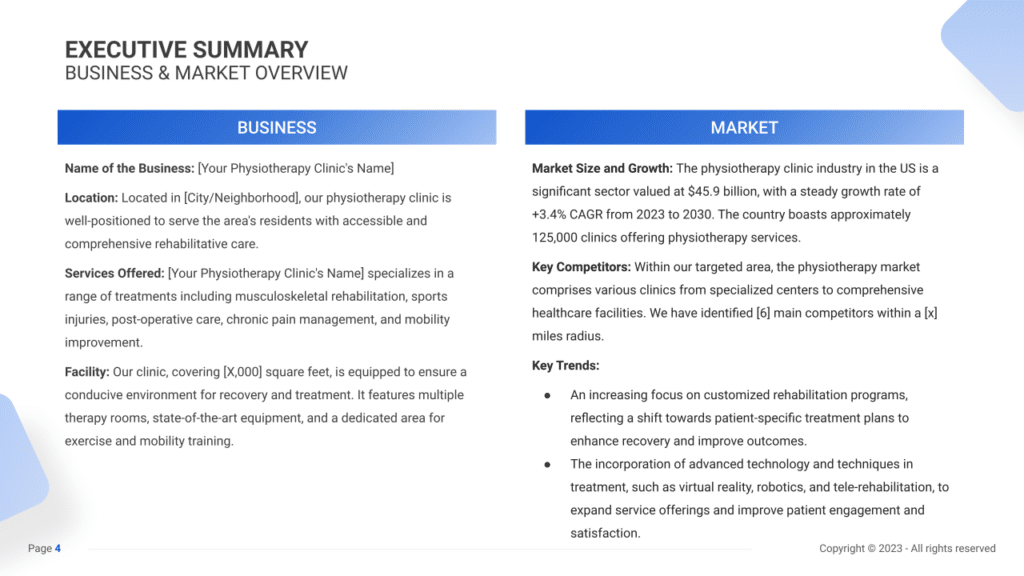
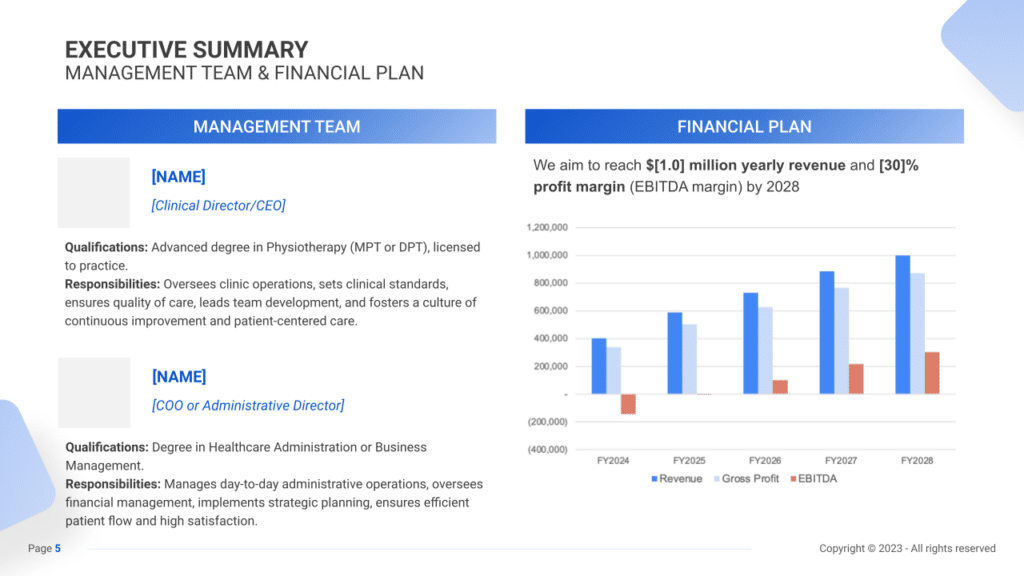
Business Overview
The business overview within the executive summary acts as an introduction to the clinic’s fundamentals. It encompasses the clinic’s name, location, services offered, and key distinguishing factors.
An emphasis on the unique services provided is essential, showcasing what sets the clinic apart in the realm of rehabilitative care. Whether it’s specialized treatments for sports injuries, tailored rehabilitation programs, or innovative approaches to chronic pain management, this section spotlights the clinic’s exceptional offerings.
Example:
“ReviveWell Physiotherapy Clinic,” in the heart of [City/Neighborhood], offers a comprehensive spectrum of rehabilitative services. Spanning across 3,000 square feet, our clinic specializes in musculoskeletal rehabilitation, sports injury recovery, post-operative care, chronic pain management, and mobility enhancement. What sets us apart is our focus on individualized care plans tailored to each patient’s unique needs, ensuring optimal recovery outcomes.
Market Overview
Understanding the market dynamics is crucial. This section should encompass the market size, growth trends, and competitive landscape within the physiotherapy and rehabilitative care industries.
Highlighting the clinic’s positioning in this landscape, whether in a burgeoning market or a niche segment, is imperative. This is the opportunity to present growth projections and market potential, backed by industry insights and statistics.
Example:
The physiotherapy clinic industry in the US is a robust sector, valued at $45.9 billion, with a steady growth rate of +3.4% CAGR from 2023 to 2030. The landscape comprises approximately 125,000 clinics nationwide, indicating a thriving market for specialized care.
Within our targeted area, [City/Neighborhood], the physiotherapy market is competitive, boasting various clinics from specialized centers to comprehensive healthcare facilities. We’ve identified [6] main competitors within a [x] mile radius.
Management Team
A robust management team is the backbone of any successful clinic. This section highlights the qualifications and expertise of key individuals steering the clinic toward success.
Profiles outlining the team’s expertise, qualifications, and relevant experience in healthcare administration or physiotherapy are showcased here. It underscores the strengths and capabilities of the team entrusted with the clinic’s operations.
Example:
ReviveWell is spearheaded by [Name], possessing a degree in Healthcare Administration and over a decade of experience in managing healthcare facilities. Responsibilities encompass overseeing day-to-day operations, financial management, strategic planning, and ensuring optimal patient experiences, setting the standard for high-quality care at our clinic.
Financial Plan
The financial overview succinctly summarizes the clinic’s financial goals, revenue projections, and financial stability and growth strategies.
This section outlines revenue targets, profitability margins, and the key strategies driving financial success, including investment plans, marketing initiatives, and community engagement strategies.
Example:
ReviveWell aims to achieve an annual revenue milestone of $1.0 million with a targeted profit margin of 30% (EBITDA margin) by 2028. Our financial strategy encompasses prudent investments in state-of-the-art equipment, continuous staff development, and community outreach initiatives. Leveraging these strategies alongside comprehensive marketing efforts and partnerships within the healthcare ecosystem, we are poised for sustainable growth and financial success in the coming years.
Business Overview
For a Physiotherapy Clinic, the sections can be adapted as follows:
Clinic & Location
Describe the clinic’s infrastructure, focusing on its therapeutic and patient-friendly design, accessibility features, and overall environment conducive to healing and rehabilitation.
Highlight the clinic’s location, emphasizing its strategic placement for easy access, such as near healthcare hubs, residential areas, or with ample parking space. Discuss the advantages of this location in terms of attracting the intended patient base, including considerations for those with mobility challenges.
Treatments & Prices
Detail the comprehensive range of physiotherapy treatments and services your clinic offers, covering areas such as acute injury management, chronic pain therapy, post-surgical rehabilitation, and specialized programs for specific conditions like arthritis, stroke recovery, or sports injuries.
Present your pricing model, ensuring it reflects the specialized care and value of your services while being competitive within the healthcare market. Emphasize any unique treatment packages, flexible payment plans, or loyalty incentives designed to enhance patient care and loyalty, fostering a long-term relationship with your clientele.
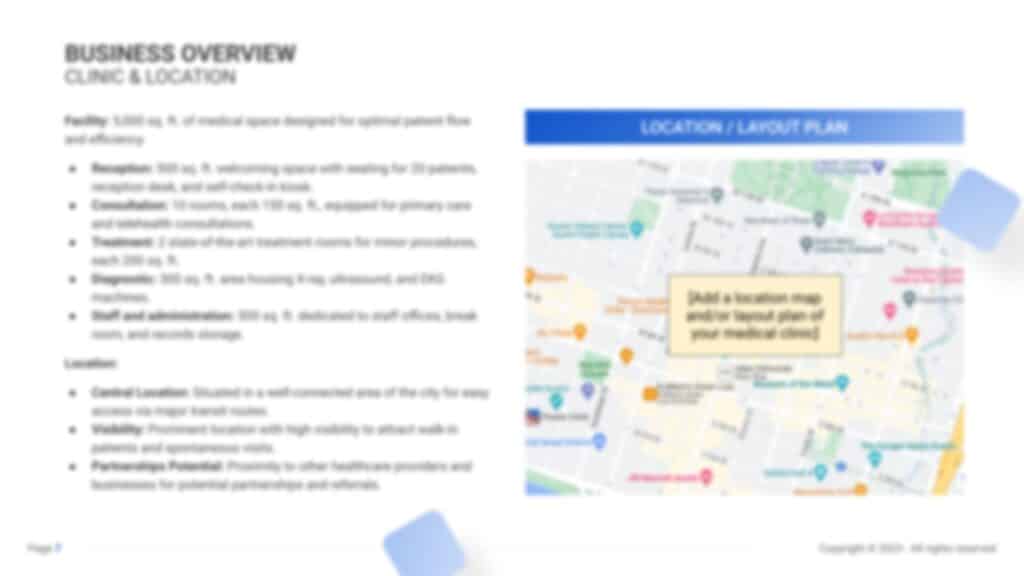
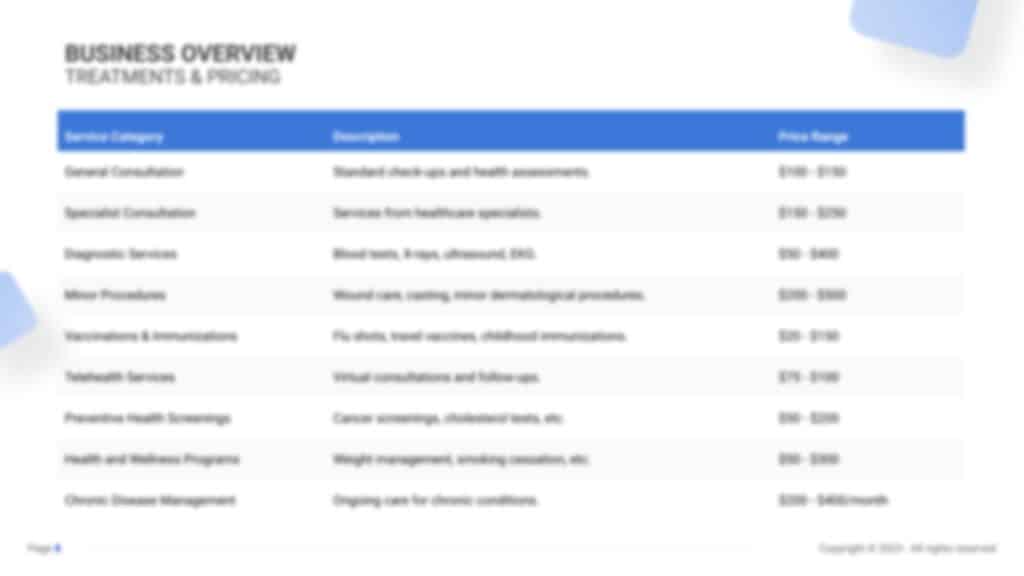
Market Overview

Industry size & growth
In the Market Overview of your physiotherapy clinic business plan, begin by analyzing the size of the physiotherapy and rehabilitation industry, along with its growth potential. This examination is essential for grasping the market’s breadth and pinpointing opportunities for growth and expansion.
Key market trends
Move on to discuss recent trends in the healthcare and physiotherapy market, such as the growing demand for personalized rehabilitation programs, an increased focus on holistic and preventative care, and the integration of technology in treatment methods.
For instance, highlight the growing preference for treatments tailored to individual health conditions and goals, as well as the surge in the use of telehealth services and digital therapy platforms.
Competitive Landscape
A competitive analysis is not just a tool for gauging the position of your physiotherapy clinic in the market and its key competitors; it’s also a fundamental component of your business plan. This analysis helps in identifying your physiotherapy clinic’s unique selling points, essential for differentiating your business in a competitive market.
In addition, competitive analysis is integral in laying a solid foundation for your business plan. By examining various operational aspects of your competitors, you gain valuable information that ensures your business plan is robust, informed, and tailored to succeed in the current market environment.
Identifying Your Clinic’s Competitors in the Physiotherapy Industry
The first step towards comprehending your physiotherapy clinic’s market position involves recognizing and mapping out local competitors. Direct competitors may include other physiotherapy clinics within your vicinity, hospitals offering similar services, or even wellness centers providing rehabilitation programs. Indirect competitors, like chiropractic clinics or fitness centers with rehabilitation services, should also be considered.
Leveraging digital tools like Google Maps, alongside industry-specific directories and platforms such as Healthgrades or Zocdoc, aids in visualizing the distribution and scope of competitor clinics. Reviews and testimonials on platforms like Yelp or patient feedback forums can unravel competitor strengths and weaknesses. For instance, glowing reviews praising the expertise and personalized care at “Wellness First Physiotherapy” can signal a significant strength of your competitor.

Physiotherapy Clinic Competitors’ Strategies
Analyzing competitors’ strategies involves a multifaceted approach:
- Specialized Services: Evaluate the range of specialized services offered by competitors. If a clinic like “Sports Recovery Institute” is gaining traction due to its specialized sports injury rehabilitation, it indicates a niche that might be worth exploring.
- Treatment Techniques and Approaches: Consider different treatment modalities and approaches adopted by competing clinics. A clinic emphasizing holistic approaches might cater to a different clientele than one focusing solely on evidence-based practices.
- Pricing Structure: Compare the pricing models of your clinic with those of competitors. Are your rates more aligned with budget-friendly clinics, or do they mirror premium clinics offering exclusive services?
- Marketing and Outreach: Assess competitors’ marketing strategies. Are they heavily invested in digital marketing, community outreach, or partnering with local sports teams and medical professionals?
- Patient Experience: Evaluate the patient experience provided by competitors. For instance, a clinic renowned for its warm ambiance and patient-centric care enhances the overall experience for patients.
- Technological Integration: Observe if competing clinics are leveraging technology for patient care, like telemedicine consultations or innovative rehabilitation equipment.
What’s Your Clinic’s Unique Value Proposition?
Reflect on your clinic’s distinct value proposition. Perhaps your clinic specializes in post-surgical rehabilitation, or you might offer a comprehensive range of pediatric physiotherapy services unparalleled in your locale.
Identify market gaps through patient feedback and emerging industry trends. For instance, the rising demand for remote physiotherapy sessions could represent an untapped market if competitors are yet to embrace this avenue.
Consider location-specific factors: A clinic situated near sports complexes might focus on sports injury rehabilitation, while a clinic in an aging population-dense area could specialize in geriatric care.
Strategy

SWOT
First, conduct a SWOT analysis for the physiotherapy clinic, identifying Strengths (such as a highly qualified team and a comprehensive range of services), Weaknesses (including potential high operational costs or intense local competition), Opportunities (for instance, a growing public awareness of the importance of physical rehabilitation and preventative care), and Threats (such as changes in healthcare regulations or economic downturns that may affect patients’ ability to afford care).

Marketing Plan
Next, develop a marketing strategy that details methods to attract and retain patients through targeted outreach, educational content, promotional offers, a strong online presence, and engagement with the local healthcare community.
Marketing Channels
Utilize a variety of marketing channels to effectively communicate your clinic’s brand and services to potential patients and the broader community.
Digital Marketing
Establish a strong online presence with:
- Social Media: Engagement through social media platforms like LinkedIn, Facebook, and Instagram should focus not only on promotional content but also on educative posts, patient testimonials, and interactive Q&A sessions. Embracing video content, such as testimonials or short educational videos, can significantly enhance patient engagement.
- Email Marketing: Email marketing campaigns, meticulously crafted with valuable content, educational resources, and occasional promotional offers, aid in nurturing relationships with both existing and potential patients.
- Website and SEO: In the digital realm, establishing an authoritative online presence is vital. The clinic’s website should serve as an information hub, providing detailed insights into the offered services, practitioner profiles, success stories, and educational resources on various musculoskeletal conditions and their treatments.
Local Advertising
Engage with the local community through:
- Print Media Advertising: Leveraging traditional methods of advertising, such as distributing informative flyers or brochures, placing ads in local publications, and participating in community events or health fairs, helps extend the clinic’s reach within the local community.
- Community Events: Participation in community events, health fairs, or sports gatherings, offering free consultations or demonstrations to increase brand visibility.
- Collaborations: Forming strategic alliances and partnerships with local businesses, sports clubs, or fitness centers can facilitate cross-promotion, broadening the clinic’s exposure among potential patients who might require physiotherapy services.
Promotional Activities
Offering personalized and engaging promotions tailored to specific patient needs can effectively attract attention and foster patient loyalty.
- Special Deals: Seasonal promotions or discounted packages such as ‘Rehabilitation Starter Kits’ or ‘Wellness Evaluation Packages.’
- Loyalty Programs: Implementing loyalty programs, not just based on service frequency but also considering active patient engagement in the clinic’s events or educational initiatives, can yield more significant patient retention.
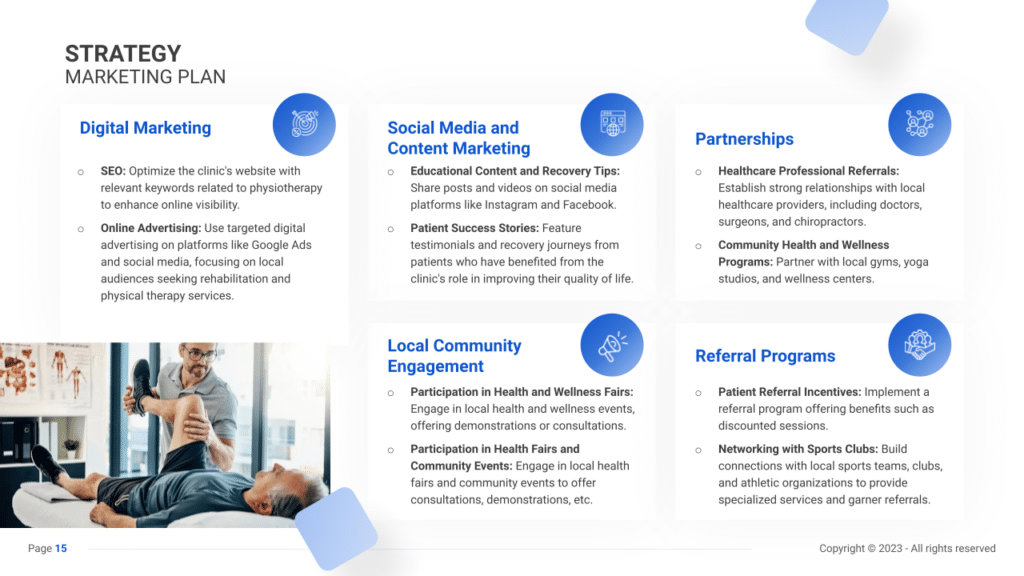
Sales Channels
Optimizing the sales strategies ensures that patients not only receive quality care but also perceive value in the services rendered.
In-Clinic Services and Upselling
- Service Add-Ons: Training staff to offer additional services or specialized therapies during ongoing sessions, tailoring these to individual patient requirements, showcases a commitment to patient well-being while potentially increasing the clinic’s revenue streams.
- Retail Products: Educating patients about supplementary products or aids and their benefits, which complement the therapy received, enhance their experience, and promote continuity of care at home.
Online Booking and Sales
- Efficient Booking Systems: A streamlined and user-friendly online booking system on the clinic’s website and social media platforms facilitates easy appointment scheduling for patients. Offering incentives for online bookings, such as a nominal discount or a value-added service, encourages patients to utilize this convenient option.
- E-Commerce: Implementing an e-commerce section on the website, selling recommended physiotherapy aids, or offering clinic-branded merchandise not only provides convenience to patients but also serves as an additional revenue stream for the clinic.
- Virtual Consultations: Virtual consultations, wherein patients can seek advice or receive tailored service recommendations remotely, open avenues for reaching patients beyond geographical constraints.
Membership and Loyalty Programs
- Membership Options: Designing membership options that offer tangible benefits, such as discounted therapy sessions or exclusive access to specialized programs, encourages patient loyalty and incentivizes continued engagement with the clinic.
- Exclusive Rewards: Digital loyalty programs, based on a points system accrued through various clinic engagements, enable patients to redeem points for discounts, free sessions, or exclusive offerings, fostering a sense of appreciation and enhancing patient retention.
Strategy Timeline
Finally, establish a detailed timeline that marks key milestones for the physiotherapy clinic’s launch, marketing initiatives, patient base development, and goals for service expansion, ensuring the business progresses with defined objectives and strategic intent.

Management
The Management section focuses on the physiotherapy clinic’s management and their direct roles in daily operations and strategic direction. This part is crucial for understanding who is responsible for making key decisions and driving the physiotherapy clinic towards its financial and operational goals.
For your physiotherapy clinic business plan, list the core team members, their specific responsibilities, and how their expertise supports the physiotherapy clinic’s mission.


Financial Plan
The Financial Plan section is a comprehensive analysis of the physiotherapy clinic’s financial strategy, including projections for revenue, expenses, and profitability. It lays out the clinic’s approach to securing funding, managing cash flow, and achieving breakeven.
This section typically includes detailed forecasts for the first 5 years of operation, highlighting expected revenue, operating costs and capital expenditures.
For your physiotherapy clinic business plan, provide a snapshot of your financial statement (profit and loss, balance sheet, cash flow statement), as well as your key assumptions (e.g. pricing strategies for memberships and services, etc.).
Make sure to cover here
_ Profit and Loss
_ Cash Flow Statement
_ Balance Sheet
_ Use of Funds









